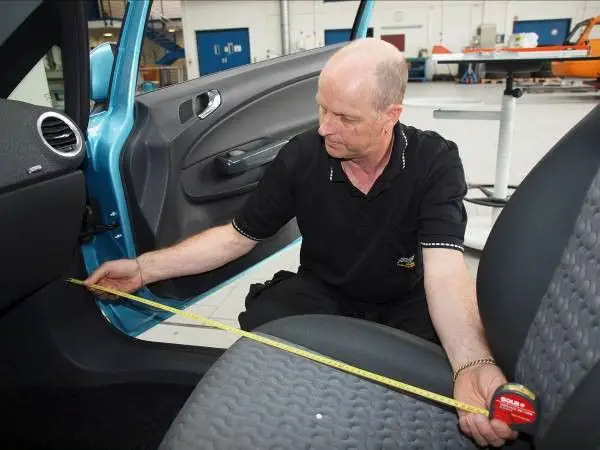What is Legroom in Cars?
Legroom refers to the amount of space available for passengers’ legs in a vehicle. It measures the distance from the back of a seat to the seat in front of it or another obstacle like the dashboard. Legroom allows passengers, especially those sitting in the rear seats, to stretch out their legs comfortably without their knees hitting the seat in front.
Legroom differs from headroom, which measures the space between the top of a passenger’s head and the ceiling of the vehicle. While legroom determines how far you can extend your legs, headroom determines how upright you can sit in your seat. Vehicles typically have more headroom in the front seats than the rear.
Sufficient legroom is an important factor for overall comfort, especially on long drives. Insufficient legroom can cause discomfort, restlessness, and pain. When buying a new or used car, checking the legroom dimensions can ensure the vehicle can accommodate you and your passengers.
Why Legroom Matters
Legroom is an important factor for driver comfort and safety. Drivers need ample legroom to properly operate the pedals and steering wheel without strain or discomfort. Insufficient legroom can lead to poor posture, restricted movement, and driver distraction.
Taller drivers especially require adequate legroom for a comfortable driving experience. Without enough legroom, tall drivers may have to contort their bodies or sit too close to the steering wheel. This can obstruct visibility, impair control of the vehicle, and increase fatigue on long drives.
According to experts, improper legroom negatively impacts driving posture and ergonomics, which are critical for road safety. Crammed legroom forces drivers into hunched or cramped positions that place more stress on the back, neck, and shoulders. Over time, this can cause pain and health issues. Proper legroom allows drivers to sit upright with their legs comfortably extended.
Additionally, sufficient legroom gives drivers room to maneuver and operate the pedals safely. With cramped legroom, drivers sit closer to the pedals and steering wheel, affording less reaction time in the event of an emergency. Legroom also determines how easily drivers can enter and exit the vehicle.
Overall, ample legroom ensures drivers can operate vehicles safely while maintaining proper posture and comfort over both short and long distances.
Legroom Measurements
Legroom refers to the amount of space available for passengers to stretch out their legs while seated in a vehicle. It is an important measurement of interior spaciousness and comfort.
Legroom is measured from a fixed point on the floor directly below the front of the seat to the back of the seat in front of it. For front legroom, the measurement is taken from the pedals to the back of the front seat. For rear legroom, it is measured from a set point on the floor to the back of the front seat [1]. Typically, manufacturers use a frontal reference point 36-40 inches from the pedals to enable standardized comparisons across vehicles [2].
Front legroom tends to be greater than rear legroom in most vehicles. This allows the driver and front passenger more space to comfortably operate the pedals and adjust their seating. Rear legroom is still important for passenger comfort, especially in larger vehicles like SUVs that may transport adults in the backseat.
Average Legroom by Car Type
Legroom can vary significantly between different vehicle types and sizes. Here’s a look at the average legroom for common car types:
Sedans
Compact sedans generally have around 41-43 inches of rear legroom. Some examples are the Honda Civic with 42 inches and Toyota Corolla with 41.4 inches (source).
Midsize sedans offer more legroom in the rear, averaging around 44-46 inches. The Toyota Camry has 44.1 inches while the Honda Accord provides 42.3 inches of rear legroom (source).
Full-size luxury sedans maximize rear seat legroom, with many large models boasting over 40 inches. The Mercedes-Benz S-Class has a cavernous 43.0 inches of rear legroom (source).
SUVs
Compact SUVs offer around 41 inches of rear legroom on average. The Honda CR-V provides 40.4 inches while the Toyota RAV4 has 37.8 inches of rear legroom (source).
Midsize SUVs have around 42-44 inches of legroom for rear passengers. Examples include the Ford Explorer with 39.7 inches and Jeep Grand Cherokee with 40.3 inches (source).
Full-size SUVs offer the most spacious rear seats, averaging 45-48 inches of legroom. The Chevrolet Suburban provides a massive 44.5 inches of rear legroom (source).
Trucks
Compact/midsize trucks have around 35-38 inches of rear legroom. The Ford Ranger offers 32.5 inches while the Jeep Gladiator has 38.3 inches (source).
Full-size pickup trucks often have crew cabs with expansive rear seats. Many boast over 40 inches of rear legroom, like the Ram 1500 with 45.2 inches (source).
Factors Affecting Legroom
Legroom in cars can vary greatly depending on several key factors related to the vehicle’s design and dimensions.
One major factor is the overall packaging and shape of the car’s interior. Smaller cars tend to have less legroom simply because there is less physical space inside the cabin. The angle of the seatback, location of the pedals, and placement of the center console can also impact usable legroom.
Seat adjustability is another key factor. Most cars allow the driver’s seat to slide and recline, which helps accommodate different sized drivers. However, cheaper base models sometimes lack seat height adjustment, and rear seats are often fixed in place.
The wheelbase – the distance between the front and rear axles – also affects legroom. A longer wheelbase spreads out the cabin space, resulting in more legroom and interior volume overall. Short wheelbase vehicles tend to feel tighter inside.
According to research by Stanglmeier et al. (2021), the average person needs at least 640mm of space to comfortably cross their legs while seated. Small cars and coupes can fall short of this threshold, leading to a cramped driver experience.
In summary, legroom is dictated by multiple aspects of a vehicle’s design, from the physical footprint to the adjustability of the seats. Car shoppers wanting more room to stretch out should look for vehicles with an accommodating cabin layout, long wheelbase, and seats that slide, recline, and raise up.
Tips for Drivers
Getting adequate legroom as a driver can greatly enhance your comfort and driving experience. There are a few things you can do to maximize the legroom in your car:
- Try out the legroom before buying. Sit in the driver’s seat and make sure you can comfortably reach the pedals and have space to move your legs. Check the adjustable range of the seat.
- Adjust your seat for more room. Move the seat as far back as possible and recline the backrest a bit. Adjust the height to give your legs more space. Many seats have levers and controls to help optimize legroom.
- Consider aftermarket modifications. You can purchase seat rail extenders to move your seat back further. Some vehicles also allow you to change out the factory seat for one with more adjustability. Handle spacers can provide some extra space as well.
Making small tweaks to your seat position and getting the right fit for your body type can go a long way in getting comfortable. Test drive different cars and utilize all seat adjustments to find optimal legroom.
Best Cars for Legroom
When looking for a car with ample legroom, there are some top options to consider across affordable, luxury, and performance categories:
For the most legroom overall, the Tesla Model X has an impressive 41.1 inches of front legroom. This electric luxury SUV maximizes interior space with its unique falcon-wing doors and lack of an engine up front. Though expensive with a starting price around $120,000, the Model X beats out all other vehicles for stretch-out space.
For an affordable sedan with generous legroom, the Toyota Camry offers 42.1 inches in the front and 38.1 inches in the rear. Priced from around $25,000, the Camry provides excellent legroom for all passengers without breaking the bank.
Luxury sedans like the Mercedes-Benz E-Class also rate very well, with 41.3 inches of stretch-out space up front. Combining luxury appointments with room to spare, the E-Class starts around $55,000 for this superior legroom.
Performance coupes can be tight fits, but the Chevrolet Corvette boasts 43 inches of legroom. This iconic American sports car offers a surprising amount of room, so taller drivers don’t have to sacrifice comfort for thrills.
Worst Cars for Legroom
When it comes to cramped legroom, there are certain models that consistently rank at the bottom. For affordable compact and midsize sedans, the Toyota Corolla, Honda Civic, and Nissan Sentra offer some of the least rear legroom according to industry research. In the midsize sedan segment, the Hyundai Sonata and Volkswagen Passat have noticeably less stretch-out space than rivals.
Among entry-level luxury cars, the Mercedes CLA-Class and Audi A3 score low for rear legroom. Performance models like the Chevrolet Camaro and Ford Mustang unsurprisingly sacrifice space for their sleek styling. For larger luxury vehicles, the Porsche Panamera and Maserati Quattroporte have tighter rear quarters compared to competitors. When evaluating these segments, it’s important to read professional reviews and test different models in person, as legroom numbers don’t always tell the full story.
Future of Legroom
As vehicles become more autonomous and self-driving capabilities advance, automakers are exploring new interior designs that prioritize passenger comfort over traditional driver-focused cockpits.
Several concept vehicles offer a glimpse into how legroom may evolve in future vehicles. For example, BMW unveiled the Vision iNext concept in 2018 with an open, airy interior and afocus on relaxation. The seats can swivel to face each other and there are no fixed controls like pedals or a steering wheel.
Similarly, Mercedes-Benz showed off the F 015 Luxury in Motion concept in 2015. It has lounge-like rear seats that can rotate for face-to-face conversations. The Nissan IMx Kuro concept from 2017 is fully autonomous and optimized for comfort. It has a flat floor and flexible seats that can be adjusted in different layouts.
As reported by USA Today, automakers are increasingly viewing the car interior as a “living space” rather than just a driver’s cockpit. With advanced autonomous driving aids and eventual self-driving cars, passengers will be free to utilize the space in new ways.
Legroom and the Driver Experience
Adequate legroom is essential to a positive and enjoyable driving experience. As one quote aptly states, “Patience is something you admire in the driver behind you and scorn in the one ahead.” When drivers don’t have enough legroom, it can negatively impact their comfort, patience, and overall attitude.
For tall drivers especially, cramped legroom can make driving an uncomfortable chore rather than a pleasant experience. As one 6’2″ driver noted on an automotive forum, “I usually find I have to bring the steering wheel as far as it will go towards me to give the correct driving position.” Without enough legroom, tall drivers are forced into awkward postures that can cause strain over time.
Most importantly, adequate legroom promotes driver safety and ability to properly control the vehicle. When legs are cramped, it can limit mobility which makes it difficult to smoothly operate pedals or perform evasive maneuvers if needed. Proper leg clearance enables free movement which contributes to driver confidence and capability behind the wheel.
In summary, sufficient legroom allows drivers of all sizes to feel relaxed and focused when driving. This enhances the overall experience and provides intangible benefits to driver morale and attitude. Automakers should continue prioritizing comfortable legroom to assure happy drivers and passengers.





